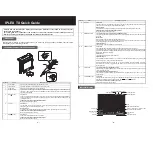
SAMPle:TIMer {<
interval
>|MIN|MAX|DEF}
SAMPle:TIMer? [{MIN|MAX|DEF}]
Sets a sample interval for timed sampling (
) when the sample count is greater than
one.
The first sample is taken one trigger delay time after the trigger (delay set by
). The second
sample starts one sample interval after the start of the first sample, and so forth, as shown below:
Note that the sample timing is determinant because the start of each sample is determined by the sample
interval. Integration and autoranging affect the sampling time for each sample, but not the sample inter-
val as long as the sample interval is longer than the sampling time. Periodic sampling continues until the
sample count (set with the
command) is satisfied.
It is recommended that all triggered measurements be made using an appropriate fixed
manual range. That is, turn autorange off (
SENSe:<function>:RANGe:AUTO OFF
), or set
a fixed range using the
,
, or
command.
When autorange is left on, the starting time of a sample becomes uncertain (when a
range change occurs) and when ranging exceeds the interval between samples; then all
subsequent samples become offset from their desired start points.
Parameter
Typical Return
<
interval
> MIN (see bullet points below) to 3600
seconds (~1 µs steps).
+3.60003
Set the sample interval to 0.1 seconds. INIT sets the meter to the "wait-for-trigger" state. When a trigger is
received from the selected trigger source, the instrument waits the trigger delay time, and then takes read-
ings every 0.10 seconds until the sample count is satisfied.
SAMP:SOUR TIM
SAMP:TIM 0.1
INIT
l
The value of MIN is measurement dependent. It depends on such things as the integration time,
autozero on or off, autorange on or off, and the measurement range. Basically, MIN is automatically
determined so that the sample interval is always greater than the sampling time (see above illus-
tration).
Execute SAMPle:TIMer? MIN to determine the recommended interval for the current
measurement configuration.
SCPI Programming Reference
310
Keysight True
volt
Series Operating and Service Guide
















































